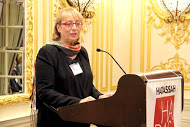
Describing the Hadassah Medical Center’s new inpatient facility– the Sarah Wetsman Davidson Hospital Tower–as “a beacon of healing that rises from the Jerusalem hillside,” Acting Director General Prof. Tamar Peretz explained to her New York audience of supporters that “a steering committee of people on both sides of the ocean worked together to plan the best hospital building in the world.”
Speaking at a “Cocktails and Conversation“ donor reception at the St. Regis hotel in New York City on October 26th, Prof. Peretz explained that the Tower was conceived to be state-of-the-art, but also welcoming; sophisticated, but environmentally sound; and a setting for world-class research. “No matter what crises we are dealing with,” she commented, “we have beautiful views and abundant Jerusalem sunshine” brightening the building.
Prof. Peretz also noted that the Tower was dedicated on Hadassah’s 100th anniversary–a gift by Hadassah to the State of Israel and named for a founding mother of Hadassah in Detroit, Michigan. Mrs. Davidson’s daughter-in-law, Karen Davidson, was one of the reception’s honored guests.
Also highlighting some of Hadassah’s key cutting-edge research, Prof. Peretz brought out that Hadassah is a pioneer in the use of stem cells. Just last month, she noted, when so many people took the ice bucket challenge in support of amyotrophic lateral sclerosis (ALS), Hadassah’s Prof. Dimitrios Karussis was completing his groundbreaking clinical trials using stem cells to halt the progression of this neurodegenerative disease. Initial results are so promising, she reported, that three American medical institutions—Massachusetts General Hospital, University of Massachusetts Memorial Hospital, and the Mayo Clinic–have launched trials using the Hadassah model. In addition, Prof. Karussis has now begun clinical trials using stem cells to treat multiple sclerosis.
At the same time, Hadassah’s orthopedist specialists, Prof. Peretz reports, are trailblazing the use of stem cells to heal complex fractures, both more successfully and faster.
When Hadassah founder, Henrietta Szold, came to pre-State Israel in 1909 with her mother, Sophie, Prof. Peretz recalls, they were troubled to see all the children with flies in their eyes, suffering from trachoma. Fast forward to today, where trachoma is no longer a problem, but aged-related macular degeneration is stealing the sight of countless people. Hadassah is pioneering the use of stem cells to improve the sight of those afflicted with this disease, hoping to begin clinical trials in early 2015.
Born in Poland to a father who fought the Nazis as a soldier in the Red Army, and a mother who was a judge, Prof. Peretz is a breast cancer specialist. At Hadassah, she related, “we recently discovered that besides Ashkenazi Jewish women, those of Sephardic background are genetically vulnerable to breast cancer. It turns out that those whose ancestors left Spain in the expulsion of 1492 also have a founder mutation.
It’s not enough for us to publish papers about this, she emphasized. Rather, as soon as Hadassah discovered these problematic mutations, its physicians met with family doctors and cautioned them not to wave away the worries of their patients who are Sephardic.
“It goes back to us being one family,” she expresses. “Our genes tie us together. So does our history. So does our future.”
Explaining that Hadassah is a role model for a world without conflict, Prof. Peretz explained how the Medical Center’s halls are filled with Jews and Arabs, Israelis and Palestinians, Maronites and Mormons, all working together; with patients of all nationalities and ethnicities sharing the same waiting rooms and coffee shops. “It’s no wonder Hadassah was nominated for the Nobel Peace Prize,” she commented.
At the same time, Prof. Peretz talked about the unrest in Jerusalem and the recent Gaza War, Operation Protective Edge. ”I don’t have to tell you there is a lot of unrest in Jerusalem and the uncertainty in the Middle East never leaves us.” That brought her back to thoughts of the operating rooms in the Sarah Wetsman Davidson Hospital Tower that need to be completed and equipped. “Without those underground operating rooms,” she noted, “we are exposed.”
Prof. Peretz is optimistic that with the help of supporters around the world, the operating rooms will be completed soon and will be able to open together with the Intensive Care Units that are a part of this emergency complex.
